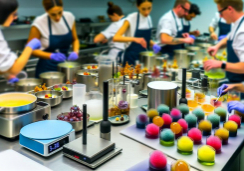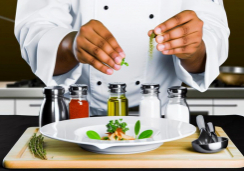Why Go Gluten-Free in Baking Recipes?
Have you ever considered the invisible thread that weaves through traditional baking, holding together the texture and taste of your favorite treats? This thread is gluten—a protein that's become a household name, often for the wrong reasons.
If you're grappling with gluten sensitivities, or if you've been diagnosed with celiac disease, you've likely felt the brunt of its unwanted effects. But it's not just about the avoidance of discomfort; going gluten-free in your baking can open up a world of culinary creativity and health benefits.
You'll discover a spectrum of alternative flours—each with unique properties and flavors—that can transform your baked goods. And while you might think this means compromising on texture or taste, let's explore how, with a few adjustments, you can achieve results that stand toe-to-toe with their gluten-containing counterparts.
Stick with me, and we'll unveil just how satisfying and varied your gluten-free baking can be, and why your oven might just become your new best friend.
Understanding Gluten's Role
Why does your bread have that satisfying chew and structure? It's largely thanks to gluten, a key protein found in wheat, barley, and rye, that plays an essential role in traditional baking. In your kitchen, gluten is the architect behind the rise and texture of many of your favorite baked goods. When kneaded, gluten proteins form an elastic network that traps air, giving bread its lofty shape and toothsome bite.
But when you're delving into the world of gluten-free baked goods, you're navigating a terrain without gluten, which means rethinking that crucial structure-building protein. Gluten-free flours lack the natural properties that give doughs and batters their elasticity and stability. That's where gluten-free flour blends and binders like xanthan gum come into play. They're designed to mimic gluten's effects, helping to achieve a desirable taste and texture in your gluten-free treats.
Successfully baking without gluten requires experimentation. Not all gluten-free flours are created equal, and they often must be combined in precise ratios to recreate the qualities you love in traditional baked goods. Certified gluten-free products take the guesswork out, ensuring that individuals with gluten sensitivities can enjoy baked delights safely. Remember, the key to outstanding gluten-free baking lies in understanding and adapting to the unique characteristics of these alternative flours.
Benefits of Gluten-Free Baking
While understanding gluten's role is fundamental in traditional baking, exploring gluten-free options offers significant benefits, particularly for those with gluten sensitivities or celiac disease. By choosing to go with gluten-free baking, you're not only catering to dietary needs but also may enjoy a broader variety of grains that enhance the nutritional profile of your baked goods.
Here's what you gain when you swap out all-purpose wheat flour for gluten-free flours in your recipes:
- Diverse Nutrition: Gluten-free flours like quinoa, amaranth, and buckwheat bring a spectrum of nutrients, including protein, fiber, and essential minerals that often surpass the nutritional value of traditional wheat flour.
- Innovative Textures and Flavors: Experimenting with different gluten-free ingredients can introduce new textures and flavors to your baking repertoire, making gluten-free bread and cookies stand out with distinctive tastes.
- Safety and Inclusion: Using certified gluten-free products and meticulous handling can prevent cross-contamination, ensuring that everyone, regardless of dietary restrictions, can enjoy your baking creations.
Gluten-free baking requires a bit of know-how, as gluten provides elasticity and structure to dough. Alternatives like xanthan gum or guar gum, and products like Gluten-Free Measure for Measure flour, help replicate these properties in a gluten-free recipe. With the right adjustments, you can produce gluten-free baked goods that are both safe and satisfying.
Mastering Alternative Flours
Diving into the world of alternative flours opens up a realm of possibilities for those aiming to master gluten-free baking, with each flour offering unique nutritional benefits and baking properties. As you explore gluten-free flours, you'll find that alternative grains like almond, buckwheat, and quinoa provide diverse flavors and textures to your creations. These gluten-free flours aren't only nutritious but also versatile.
When you're transitioning from traditional wheat flour, using a measure for measure flour can make your journey into gluten-free baking smoother. These specially formulated flour blends are designed to be used as a 1:1 substitute for all-purpose flour, ensuring that you can follow your favorite recipes with ease.
But to truly excel in gluten-free baking, understanding the science behind flour blends is essential. A well-crafted blend will replicate the properties of wheat flour, giving your gluten-free dough the structure and elasticity it needs. Additives like psyllium husk and xanthan gum can improve the texture of your baked goods, providing the binding qualities that gluten typically offers.
How Does Going Gluten-Free in Baking Improve Recipe Innovations?
Mastering gluten-free baking recipe innovations involves using alternative flours like almond, coconut, or rice flour. This leads to discovering new textures and flavors in baked goods that can enhance the overall experience for those seeking gluten-free options. Going gluten-free in baking can open up a whole new world of creativity.
Adjusting Baking Techniques
To achieve the best results in gluten-free baking, it's crucial to adjust your baking techniques to accommodate the unique characteristics of gluten-free flours. Gluten-free flours often behave differently than wheat flour, and understanding these nuances will help you create delicious baked goods with the desired final texture.
Here are a few adjustments to consider:
- Mix It Up: Don't be afraid to mix your batter more than you'd with gluten-containing recipes. Overmixing isn't an issue with gluten-free baking and can actually help improve the structure and texture.
- Rest and Hydrate: Allow your batter to rest before baking. This step gives the flours and starches time to hydrate, which is essential for a softer, more palatable final product.
- Leavening and Volume: Increase the amount of leavening agents you use in recipes that call for gluten-free flours. More leavening helps add volume and lightness to your baked goods.
Make sure to also account for the increased liquid absorption by adding more liquid per cup of gluten-free flour than you'd with wheat flour. This might result in a looser batter, but don't be alarmed—it's normal.
Additionally, monitor your baking times closely; gluten-free batters may require longer in the oven to set properly and shouldn't be removed prematurely to avoid a gummy texture.
If you're making a bread recipe gluten-free, store it in the refrigerator to maintain freshness, as these breads can spoil more quickly than their wheat-based counterparts.
Preserving Product Freshness
Ensuring your gluten-free ingredients and baked goods retain their freshness not only impacts flavor but also preserves their nutritional value. As a gluten-free baker, you're probably aware that gluten-free flour mixes can be more perishable than traditional all-purpose flour. To combat this, store your gluten-free grains and starches in smaller quantities. This approach helps maintain freshness since you're less likely to have large amounts sitting unused for extended periods.
When it comes to longevity, don't shy away from using your refrigerator or freezer. These appliances are allies in extending the shelf life of your gluten-free ingredients. For instance, transferring your gluten-free flour to an airtight container and placing it in the refrigerator or freezer can preserve its quality. Similarly, baked goods should be cooled on a wire rack to avoid sogginess and then stored properly—preferably in an airtight container at room temperature. If you won't consume them quickly, consider freezing leftovers to keep them fresh.
Don't forget to label and date your containers. This step is crucial in keeping track of when you stored your items. Plus, always store your gluten-free products away from direct sunlight and heat sources to maintain their best condition. Remember, some ingredients like dry milk solids or cottage cheese, may require overnight storage in the refrigerator to ensure maximum freshness.
Conclusion
Embracing gluten-free baking can transform your culinary experience, especially if you're sensitive to gluten. By mastering alternative flours and tweaking techniques, you'll unlock a world of flavor without the discomfort.
Remember, the right blend of ingredients ensures your baked goods remain fresh and delightful. Dive into gluten-free recipes and enjoy the nutritional benefits while satisfying your sweet cravings.
It's a journey worth exploring for your well-being and taste buds alike.










